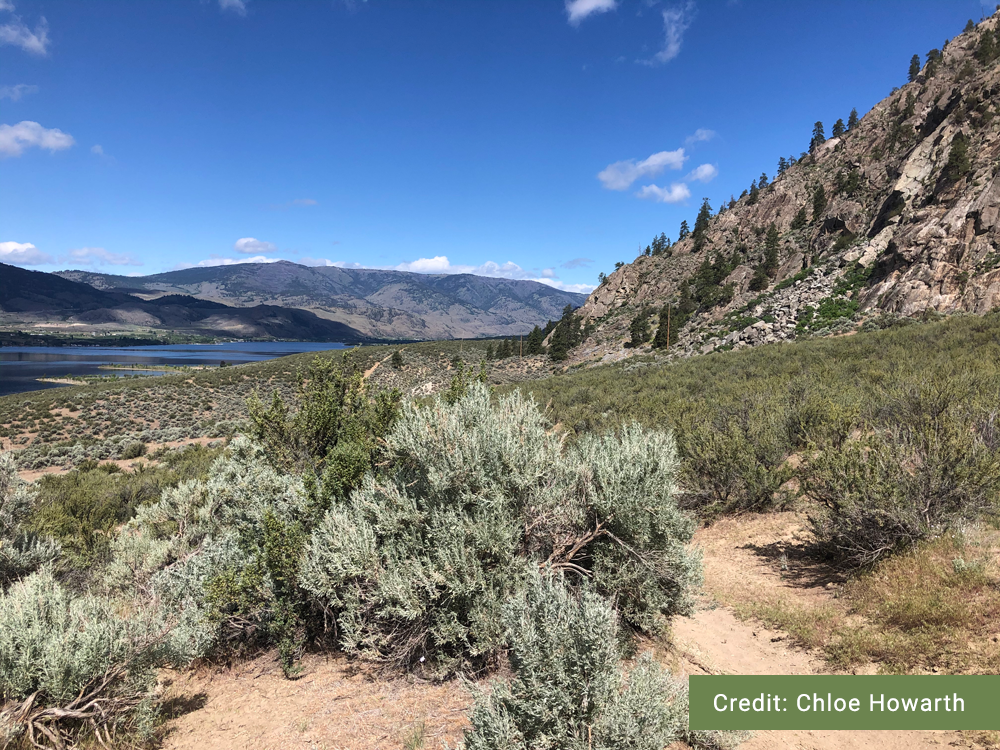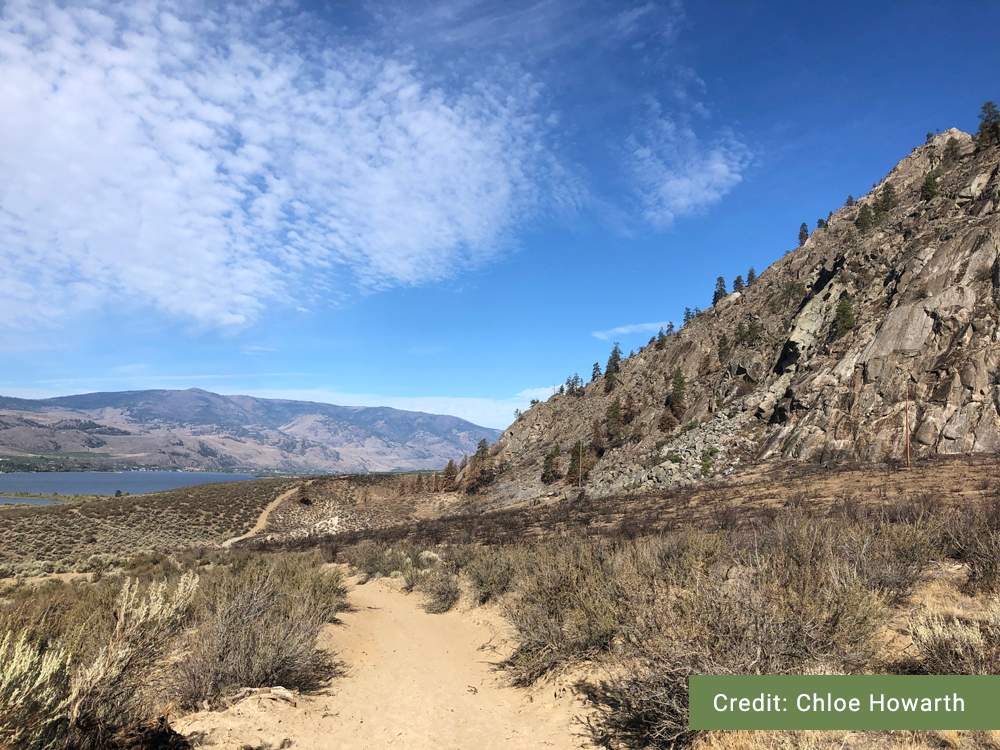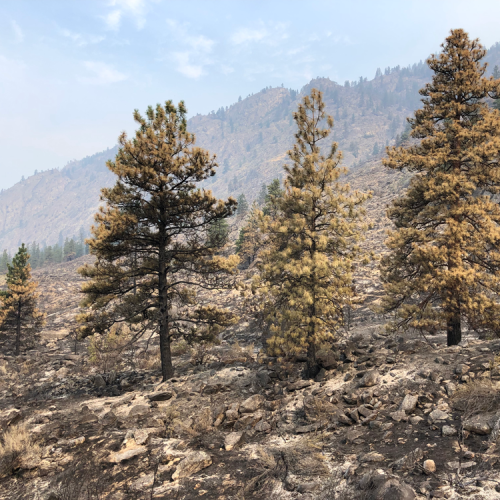Wildfire
A Brief Background on Wildfire in B.C.
Many of British Columbia’s reptile and amphibian species are found within shrub steppe, open grasslands, or open-spaced Ponderosa Pine/bunchgrass ‘parkland’. These open, bunchgrass-dominated ecosystems contain high values for biodiversity, concentrations of species-at-risk, and livestock forage. However, these ecosystems are becoming increasingly rare, as they are overshadowed by encroaching Ponderosa Pines, and eventually Douglas-fir. In the valley bottoms of southern British Columbia, frequent low-intensity fires controlled forest growth, allowing grassland ecosystems remain open and support native ungulates like Elk, while mid-elevation Ponderosa stands remained well-spaced and multi-successional (i.e. a healthy mixture of young and old trees).
Research has shown that maintaining grasslands and parklands in this fashion required much more careful management than nature alone is capable of. The indigenous peoples of British Columbia have used fire for at least 7,000 years to maintain suitable ecosystems for foraging and hunting by preventing overgrowth and forest encroachment. In the last two centuries, anthropogenic fire – a crucial aspect of indigenous livelihood – has been removed from many areas and communities. The expansion of government forestry brought with it widespread fire suppression to maintain timber stands to be harvested for profit. As the forestry industry boomed, traditional burning practices were strongly discouraged. The suppression and exclusion of fire in Ponderosa stands and grasslands has been followed by forest ingrowth (denser stands) and encroachment (expansion into open grasslands). Many years of fire suppression has resulted in a string of changes – bunchgrass grasslands replaced by Ponderosa Pine stands with dense, volatile understories, Douglas-fir encroachment, canopy closure, and dense undergrowth. Denser forest stands are highly susceptible to pathogens, insects (such as the Mountain Pine Beetle), and high-intensity fires.
Unfortunately, many land managers and large segments of the general public do not perceive fire suppression as a disturbance. Most people are unaware of the ecological consequences of fire suppression to forest health, biodiversity, grazing values, and ecosystem resilience. However, many scientists now suggest that mimicking historical fire disturbance patterns is one of the most effective ways to restore ecological integrity and resilience, and help prevent the destructive, large-scale, high-intensity fires seen across British Columbia in recent years. It is important to note that a return to a frequent, low-intensity fire regime will not eradicate the risk of occasional high-intensity fires, as these fires are often promoted by severe droughts and/or climate oscillations. The recent large, intense fires in the dry forests of southern BC (e.g. Kelowna and Barriere, 2003; Lillooet, 2007 & 2010; and the major fires of 2018 and 2021) have far greater negative ecological consequences than frequent, low-intensity fires. However, there is ‘no one-size fits all’ fire regime. Each ecosystem requires its own unique mixture of patches, edges, corridors, and ranges of fire intensities for effective management. Fortunately, research on the effects of prescribed burning has been a ‘hot’ topic in recent years, adding to the body of knowledge for managers to draw on.
Effects of Fire on Wildlife
In general, wildfire can cause three main levels of disturbance to animals:
1. Fire can cause injury or death to individuals, or it can force individuals to move from (or into) burned areas. High temperatures, toxic smoke fumes, and oxygen depletion can cause mortality or severe injury.
2. Should enough individuals in a population survive a fire event, the population may still suffer the effects of post-fire processes due to a lack of resources such as starvation, predation, or immigration to burned areas.
3. Over many generations, a fire regime can cause species to develop adaptations to fires.
These three levels can be roughly translated to:
2. Indirect Effects that influence a population or a species after fire.
3. Evolutionary Effects of fire on animal species.
Background Continued…
Fire in terrestrial ecosystems can have impacts in surrounding or linked aquatic ecosystems. The mortality or injury of aquatic species can be caused by fire raising water temperatures to lethal levels, potentially lethal changes to water pH, and the accumulation of toxic chemicals from burn run-off. Fire can also have long-term effects on aquatic ecosystems through erosion, channel reconfiguration, changes to the quality and quantity of coarse woody debris, reduced edge vegetation, turbidity, and stream sedimentation. These factors have direct and indirect effects on aquatic species like frogs, toads, and amphibians. For example, the effects of fire can impact the emergent stages of insects, which are important food sources for many vertebrates and other insects. In general, smaller water bodies are more likely to be affected than larger ones, flowing water is more affected than standing water, and aquatic habitats next to forests are more affected than those buffered by wetlands.
The balance of the benefits and consequences of fire is certainly an area of interest, and cause of concern, for the management of many wildlife species, especially species-at-risk. For threatened or endangered species, the mortality of even a few adults and juveniles can lead to population declines. The losses of a few individuals may be acceptable if the long-term benefits to the habitat increase the fitness of individuals in the population that survive or immigrate into burned areas. The biggest concern about mortality from fire is the potential loss of an entire population of a rare species.
Research has shown that fire, in general, has little direct effect on most amphibian and reptile species, with the greatest threat directed at species that require leaf litter or other surface cover that is burned. Species that are associated with ecosystems that traditionally experienced fire events are highly likely to be behaviourally adapted to protect themselves from fire mortality. In fact, some researchers suggest that fire suppression – and subsequent canopy closure and reduction of open habitats – is a much more substantial concern for reptile and amphibian species.
Species-Specific Responses to Fire
Many quick-moving or mobile animals like birds and large mammals may be more capable of escaping fire events. However, for less mobile species like most amphibians and reptiles, there are many interesting questions that biologists are trying to answer: Do they actively seek shelter, or do they remain in their pre-fire locations? What exposure to heat and gas do they experience? If they are exposed, do they experience injury or death? How do different fire intensities affect these species?
Many species have evolved adaptations to sense fire before it is too late. Chemo-reception (smell or taste) of smoke, responses to heat, visual perception of flames and smoke, and even detection of fire sounds are all ways that wildlife have adapted to escaping fire. For example, Reed Frogs (Hyperolius nitidulus) in western Africa have been shown to move to, and take cover in, fire resistant sites in response to playbacks of fire sounds. Eastern Fence Lizards (Sceloporus undulatus) have been observed burrowing and climbing trees to avoid fire – a strategy that could only be employed if they sensed a fire coming. In Arizona, eight radio-tagged individuals from three species of montane rattlesnake (Crotalus lepidus, Crotalus molossus, and Crotalus willardi obscurus) all survived a low intensity ground fire by retreating to underground shelters. Even prey items for many snake species, such as the Meadow Vole (Microtus pennsylvanicus) have been shown to escape fire by finding underground shelter, fleeing to unburned areas, or by moving to the bare ground of a Pocket Gopher (Geomys bursarius) burrow mound.
With the increased advocacy to reestablish a more natural or traditional fire regime, there has been an increase in research on how amphibian and reptile species respond to prescribed burns, with many of these studies concluding that species often possess adaptations or behavioural responses that make them resilient to frequent, low-intensity fire. For example, a study investigating the effects of a prescribed burn on Eastern Diamondback Rattlesnakes (Crotalus adamanteus) recorded only one fatality – a 3-month-old juvenile – while several unharmed adults were observed “crawling around in the smoking ashes”. Another study that tracked 68 Eastern Diamondbacks over 5 years of annual prescribed burns documented only two deaths. Both individuals killed by fires were both in the middle of ecdysis; a period during which the snakes’ senses were impaired. Overall, most studies suggest that amphibians and reptiles that have evolved in ecosystems that traditionally experience fire do not appear to be disturbed by approaching fire, and tend to respond in adaptive ways that minimize death.
Escaping the initial fire is only part of successfully surviving a fire event as species still must be able to survive in post-fire environments. Unfortunately, understanding how populations oscillate in response to fire requires long-term studies that are uncommon as they are typically resource intensive. While we are still learning about how species and populations interact with newly burned habitats, the general sentiment is that herpetofauna generally do well. For example, large breeding choruses of frogs have been observed in wet areas immediately after fires surrounded by still smoking ashes. Columbia Spotted Frogs (Rana luteiventris) showed no difference in occupancy or colonization of wetlands before and after fire. Western Toads (Anaxyrus boreas) in Glacier National Park were found to significantly prefer severely burned habitats. In another study, Western Toads were found colonizing and breeding in post-fire wetlands where they were not observed before burning. However, the occupancy of Western Toads in these wetlands declined 2 to 3 years after the fire, suggesting that Western Toads experience short-term benefits from fires. Long-toed Salamanders (Ambystoma macrodactylum) have also been reported to have higher occupancy and colonization rates after a fire. In another recent study, Racers (Coluber contrictor) and Garter Snakes (Thamnophis sirtalis) were shown to prefer unburned habitats with tall vegetation and abundant litter and generally avoided newly burned areas, but, after just one season of growth both species used both burned and unburned habitats.

Before

After

Summary
We are still developing our understanding of wildfires and prescribed burns, and how organisms react to them. Although there is still much to learn, the currently available information indicates that fire has little direct effect on most amphibians and reptiles, leading many biologists to believe that many herpetofauna species have evolved with fire, developing adaptations along the way. In terms of habitat and ecosystem management, it is likely that the mortality that does result from fire may be outweighed by the benefits of increased habitat diversity and the maintenance of habitat resources. However, it is still important to ensure mortality due to prescribed burn is minimized to ensure populations are not adversely affected in the long-term, especially when species-at-risk are present. When species-at-risk are present, the general consensus for prescribed burns is to err on the side of caution. This does not necessarily mean that prescribed burns should not be performed, but may need to be tailored to the specific system in question. For example, given the Threatened status of Massasauga Rattlesnakes (Sistrurus catenatus) in Canada, experts recommend that burns be limited to periods when the snakes are less likely to be active like before emergence from, or after return to, overwintering sites.
The study of how wildlife species respond to wildfire and prescribed burns is a relatively new field of research, and there is still much that we do not know. The effects of fire on the habitats of herpetofauna species are not straightforward as they are tied to many other processes such as urbanization, invasive species, overgrazing, forestry, and other anthropogenic activities creating a suite of complex interactions. Still, with wildfires becoming more and more commonplace in British Columbia, people are becoming increasingly curious about how we can mitigate the effects of high-intensity fire events and promote healthier, more resilient ecosystems in the face of climate change.
Beane JC. Sceloporus undulatus hyacinthinus (Northern Fence Lizard) fire avoidance behavior. Herpetological Review. 2006;37:92.
Bisson PA, Rieman BE, Luce C, Hessburg PF, Lee DC, Kershner JL, Reeves GH, Gresswell RE. Fire and aquatic ecosystems of the western USA: current knowledge and key questions. Forest Ecology and Management. 2003 Jun 3;178(1-2):213-29.
Cross MD. Multi-scale responses of eastern massasauga rattlesnakes (Sistrurus catenatus) to prescribed fire. The American Midland Naturalist. 2015 Apr;173(2):346-62.
Dunham JB, Rosenberger AE, Luce CH, Rieman BE. Influences of wildfire and channel reorganization on spatial and temporal variation in stream temperature and the distribution of fish and amphibians. Ecosystems. 2007 Mar;10(2):335-46.
Engstrom RT. First-order fire effects on animals: review and recommendations. Fire Ecology. 2010 Apr;6(1):115-30.
Frost PG. The responses and survival of organisms in fire-prone environments. In Ecological effects of fire in South African ecosystems 1984 (pp. 273-309). Springer, Berlin, Heidelberg.
Gayton D. Documenting fire history in a British Columbia ecological reserve. Journal of Ecosystems and Management. 2013 Apr 9;14(1).
Geluso KN, Bragg TB. Fire-avoidance behavior of meadow voles (Microtus pennsylvanicus). American Midland Naturalist. 1986 Jul 1:202-5.
Grafe TU, Doebler S, Linsenmair KE. Frogs flee from the sound of fire. Proceedings of the Royal Society of London. Series B: Biological Sciences. 2002 May 22;269(1495):999-1003.
Gresswell RE. Fire and aquatic ecosystems in forested biomes of North America. Transactions of the American fisheries society. 1999 Mar 1;128(2):193-221.
Hileman ET, King RB, Faust LJ. Eastern massasauga demography and extinction risk under prescribed‐fire scenarios. The Journal of Wildlife Management. 2018 Jul;82(5):977-90.
Lewis M, Christianson A, Spinks M. Return to flame: reasons for burning in Lytton First Nation, British Columbia. Journal of Forestry. 2018 Mar 12;116(2):143-50.
Means DB, Campbell HW. Effects of prescribed burning on amphibians and reptiles. In Prescribed fire and wildlife in southern forests: Proceedings of a symposium 1981 Apr 6 (pp. 6-8).
Russell KR, Van Lear DH, Guynn Jr DC. Prescribed fire effects on herpetofauna: review and management implications. Wildlife Society Bulletin. 1999 Jul 1:374-84.
Setser K, Cavitt JF. Effects of burning on snakes in Kansas, USA, tallgrass prairie. Natural Areas Journal. 2003 Oct 1;23(4):315-9.
Smith LJ, Holycross AT, Painter CW, Douglas ME. Montane rattlesnakes and prescribed fire. The Southwestern Naturalist. 2001 Mar 1:54-61.
Webb JK, Shine R. Differential effects of an intense wildfire on survival of sympatric snakes. The Journal of Wildlife Management. 2008 Aug;72(6):1394-8.










